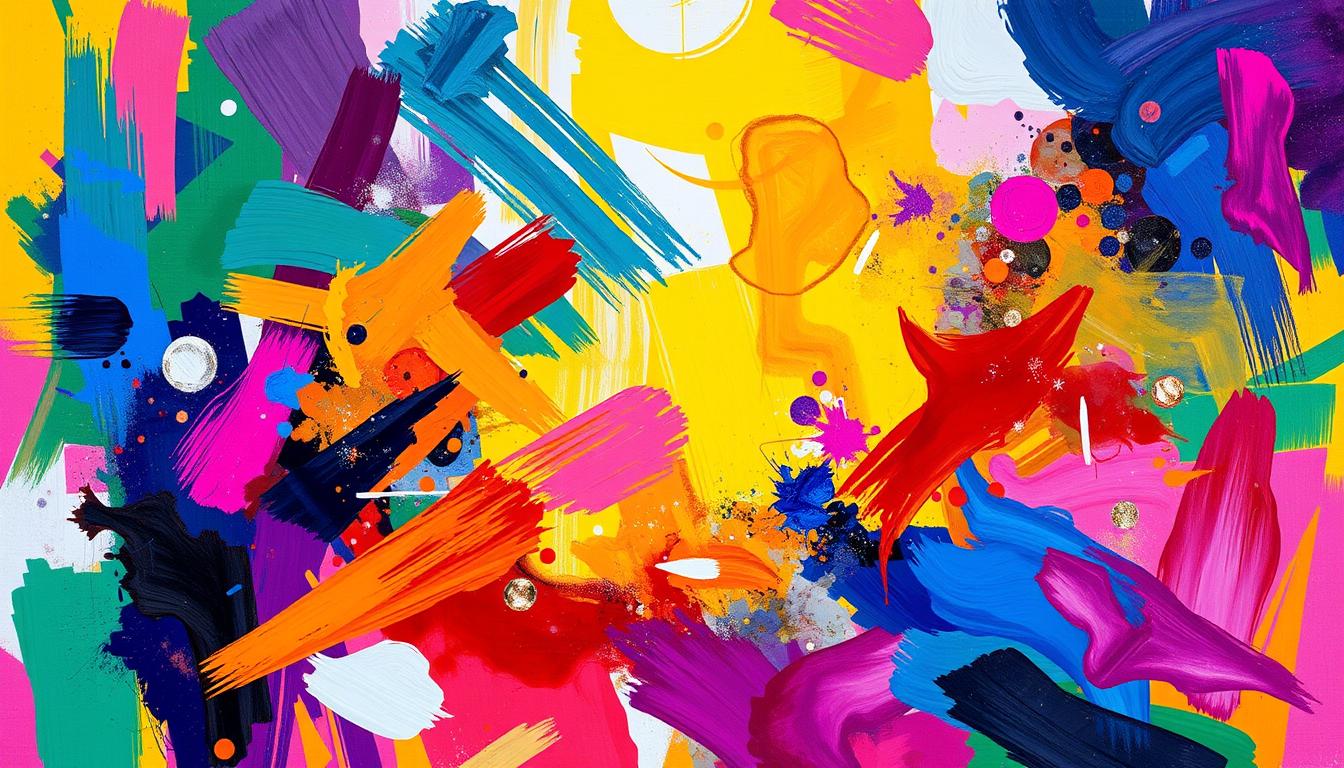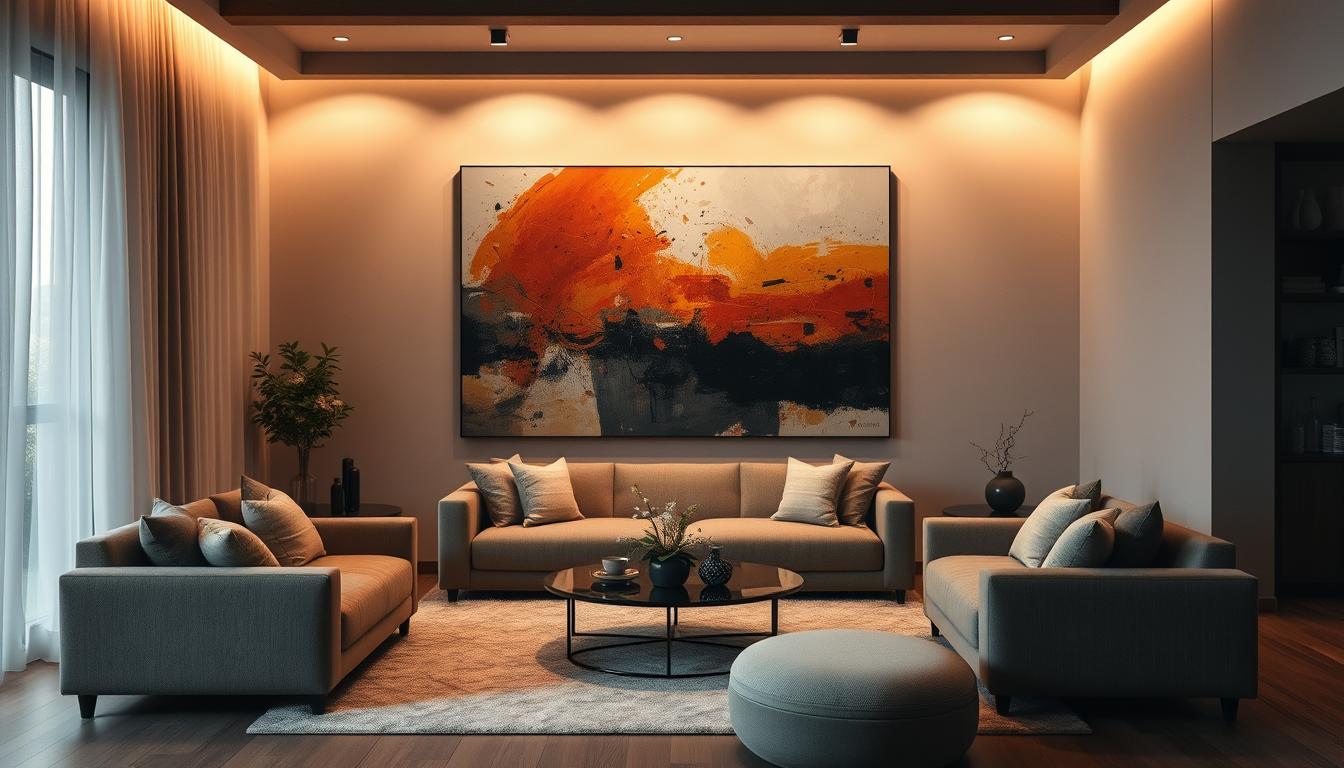What if a painting could speak without using a single image you recognize? This question invites the reader to pause and wonder about art that does not copy the world. It opens a path for curiosity and a fresh way of seeing.

Abstract art moves away from literal pictures and uses shapes, colors, and marks to share an artist’s feelings. The viewer is asked to bring an open mind and let personal meaning emerge. This way of looking rewards patience and time.
Readers will find an accessible guide that explains how to notice composition, rhythm, and color without overthinking. It reassures people who feel unsure at first and shows how to connect what they see with their own emotions.
Rossettiart LLC appears as a practical option for those who want ready pieces. Their archival prints keep vibrant colors from fading, and handcrafted frames arrive Ready to Hang with the artist’s initials and year for an exclusive touch.
Key Takeaways
- Abstract works express feelings through form and color rather than clear subjects.
- An open mind helps the viewer build a personal experience.
- Short, patient viewings grow into richer meaning over time.
- Focus on composition, rhythm, and colors to start interpreting artwork.
- Rossettiart LLC offers archival prints and ready-to-hang framing for lasting quality.
What Is Abstract Art and Why It Matters Today
In some paintings the subject melts away, leaving color and form to convey feeling. This approach puts emphasis on shapes, lines, and other visual elements rather than clear objects or scenes.
From representation to expression: a quick definition
Abstract art does not attempt to reproduce real objects. Instead, it relies on colors, shapes, and gestures to evoke emotion and mood. Some artists simplify a subject; others begin with a palette or a feeling and let forms evolve on the canvas.
No single right answer: embracing open interpretation
"Meaning changes with each viewer, and that is part of the point."
There is no single answer to what a piece means. Personal interpretation is the goal: viewers bring context and a sense of openness.
Why abstract art resonates in the present
Today, this work offers quiet space in a busy world. Colors and shapes can create harmony or tension, guiding the eye and suggesting movement and energy. For living-room-ready options, explore prints and framing at Shop or ask questions via Chat.
A Beginner’s Guide to Understanding Abstract Art
Think of a canvas as a score: marks and color play like notes that shape meaning. Start with an open mind and an empathetic look at the artist’s process.
Think like the artist: intention, process, and empathy
Consider why the artist chose certain shapes or strokes. Notice decisions that suggest mood or motion rather than literal subject matter.
Approach it like music: feel first, label later
Let rhythm, tone, and pacing land before naming parts of the work. Absorb the feeling and then ask what images or memories arise.
Let go of “what is it?” and look for energy, mood, and movement
"Meaning comes from the dialogue between viewer and piece."
Track where the eye moves and which colors or edges hold attention. Over time, interpretation and understanding will deepen with repeated viewings.
If a work speaks to them, readers can save it or explore ready-to-hang prints. Curious people may ask questions via Chat and learn more about bringing a favorite piece home.
How to Look at Abstract Art: A Step-by-Step Viewing Method
Stand back and take in the painting as a single field of energy and balance. This quick scan helps the viewer notice whether the whole feels calm, tense, or in motion.
First pass: overall composition, harmony, and balance
Scan the composition for major areas of activity and quiet. Look for how shapes and values create a sense of harmony or productive tension.
Second pass: color, line, shape, texture, and space
Now study the elements. Note how color sets mood, how line and shape direct the eye, and how texture gives the surface depth.
- Trace perceived movement across the picture plane.
- Watch transitions and edges for changes in pace and rhythm.
Slow down: give the artwork time to speak
Average viewing time in museums is short. Spend more time and layers will emerge. Stepping back shows balance; moving closer reveals mark-making and detail.
Trust your gut: personal connection over perfection
If a passage repeatedly resonates, that sense matters more than technical “rightness.” Collectors who feel a strong bond with a piece can choose Ready to Hang framed prints; see options at https://rossettiart.com/.
"Give a work time, and it often returns something new."
Core Elements of Abstract Painting: Color, Composition, and Texture
Composition is the unseen architecture that makes an artwork feel intentional and alive.

Placement, focal areas, and visual flow
Composition organizes where elements sit on the canvas. Focal areas and spacing guide the eye and create visual flow.
Ask if the pathways between marks lead naturally. Repetition, variation, and balance help parts feel connected.
Harmony, contrast, and palette choices
Color and a thoughtful palette set mood. Warm and cool shifts, saturation changes, and neutral anchors create either energy or calm.
Contrast makes moments pop; close values build quiet harmony. Good color work holds attention without shouting.
Thickness, layering, and surface interest
Texture gives depth. Thick paint, thin washes, or delicate scumbles change how light plays on the surface.
Consider whether texture is deliberate and if the canvas scale matches the painting’s ambition.
Line, shapes, and form as visual language
Lines, shapes, and forms act like grammar. Edges and planes suggest structure without naming objects.
- The section explains composition as the architecture that guides the viewer.
- Color and palette decisions influence emotion and coherence.
- Texture and surface treatments add tactile and visual depth.
- Line and forms build the work’s visual vocabulary.
Practical note: For those who want these qualities at home without deep research, Rossettiart LLC offers archival prints and handcrafted frames that showcase composition, color, and texture to gallery standards.
"When elements align, the artwork invites return viewings."
Creating Abstract Art: Techniques, Materials, and Practice
Small experiments — like turning the panel midwork — break predictable marks and reveal new directions when creating abstract art.
Techniques that invite discovery
Flip the canvas to reorient composition and spot fresh balances. Work to music so tempo and dynamics shape gesture and pace.
Mix media—charcoal under washes or pastel over paint—to add depth and contrast. These moves invite surprise and honest choices.
Quality materials that last
Use professional paint, a stable ground, and a durable surface. Better materials improve color fidelity and how layers cure over time.
From intuition to iteration
Start with instinct, then test, note, and repeat. Set short experiments, limit a color family, and track recurring shapes as part of a signature.
"Time and patient repetition let an artist refine voice and strengthen each work."
| Focus | Practice | Benefit |
|---|---|---|
| Flip canvas | Rotate mid-process | New composition options |
| Music | Paint with tempo | Natural rhythm and energy |
| Mixed media | Layer charcoal, pastel, paint | Richer surface and voice |
| Materials | Professional paints and grounds | Durability and true color |
Practical note: For people who want lasting work without the studio time, Rossettiart LLC offers Built to Last archival prints and handcrafted frames. Shoppers can explore sizes and Ready to Hang options at https://rossettiart.com/ and ask questions via Messenger: https://m.me/104795508292657.
How to Identify Quality Abstract Artwork as a New Collector
A quality piece often reads like a practiced language, with composition and mark-making in dialogue.
Start by evaluating composition. Look for balanced focal areas, a clear visual flow, and overall harmony among shapes and color. Good artwork rewards repeated viewings rather than fading after a glance.

Signals of craft and technique
Confident technique shows as decisive marks, clean transitions, and a surface that feels intentional. Check the texture and surface for thoughtful layering. Ask the artist about paints, grounds, and the canvas to judge durability.
Emotion and lasting connection
See whether the piece holds attention and sparks emotions over time. A work that sustains curiosity often has depth beyond trend or novelty.
Weigh reputation and personal response
Consider an artist’s track record, but give weight to personal resonance. Living with paintings is intimate; trust what genuinely moves you while noting technical quality.
Viewing checklist
- Balance: focal points and flow feel intentional.
- Unity: palette supports mood without competing elements.
- Craftsmanship: marks, edges, and surface show control.
- Durability: materials and framing suit long-term display.
Practical next steps: compare several works side by side, then explore archival prints with handcrafted poplar floater frames at https://rossettiart.com/. Use 💬 Chat for questions and consider Ready to Hang options for an easy start.
Discover Abstract Art You Can Live With: Rossettiart

Built to last: Rossettiart uses premium archival materials so colors stay vibrant over time. The prints resist fading and keep the original energy of the work for years.
Built to last: archival prints with vibrant color that won’t fade
Archival papers and inks protect pigment and texture. Collectors get a piece that looks fresh long after purchase.
Sophisticated frames: handcrafted poplar floater frames, ready to hang
Handcrafted poplar floater frames give each canvas room to breathe. Pre-installed hardware moves art from box to wall in minutes.
Exclusive touch: each print signed with initials and original year
Every print bears the artist’s initials and year. This small mark adds provenance and a personal link between owner and artist.
Explore and connect: shop and socials
Sizes include larger formats so a statement piece can anchor a room. For details, chat for materials, sizing, or delivery time.
| Feature | Benefit | Why it matters |
|---|---|---|
| Archival print | Vibrant colors last | Preserves the piece for years |
| Poplar floater frame | Gallery-ready look | Shows texture and canvas edge |
| Signed with initials & year | Provenance | Added collector value |
| Ready to Hang | Pre-installed hardware | Easy installation, saves time |
Shop: https://rossettiart.com/ · Explore: https://rossettiart.com/collections/canvas-print · Chat: https://m.me/104795508292657
Conclusion
Closing this guide, remember that careful looking reveals what a piece quietly holds. Patient viewing lets shapes, form, and color move from notes into meaning for each viewer.
Key idea: open interpretation paired with an element-by-element look gives a reliable way to judge quality and feel. Spend time with paintings, compare a few side by side, and choose what still resonates after a day or two.
Next steps: explore archival, Ready to Hang prints at https://rossettiart.com/, ask questions via 💬 Chat, and follow for new work on 📸 Instagram and 🔵 Facebook. Keep looking—understanding grows with each new experience.
FAQ
What makes nonrepresentational paintings meaningful?
They focus on mood, form, and color rather than recognizable subjects. Viewers can respond to energy, rhythm, and texture much like they react to music. A strong piece balances composition and emotional intent so people feel invited to explore rather than decode a literal scene.
How should someone begin looking at an abstract piece?
Start with a quick sweep to take in the whole composition, then linger on color relationships, lines, and surface details. Let impressions form without rushing to label them. Giving the work time often reveals patterns and emotional cues that aren’t obvious at first glance.
What elements indicate good composition in an abstract painting?
Look for clear focal areas, visual flow that guides the eye, and a sense of balance between shapes and empty space. Cohesive palette choices and confident marks or brushwork also suggest that the artist controlled their choices rather than relying on accidental results.
Are there materials that make abstract pieces more durable?
Yes. Archival-quality paints, stable grounds, and proper primed canvases or panels increase lifespan. For prints, pigment-based inks and acid-free paper or canvas help maintain color. Good framing and UV-protective glazing also safeguard the surface from light and dust.
How can a new collector tell if a work connects with them personally?
Trust gut response: if a piece holds attention or evokes a feeling, that connection matters. Consider how the work fits a space in scale and color, and whether it still resonates after multiple viewings. Emotional resonance often outweighs market hype for long-term satisfaction.
What practical techniques help artists develop an original abstract style?
Experimentation drives originality: flip the canvas, combine mixed media, or paint while listening to different music to influence tempo. Repeating processes and refining favored marks, palettes, and textures turns spontaneous gestures into recognizable signature traits.
How does texture influence the reading of a piece?
Texture adds tactile interest and alters how light interacts with the surface, creating depth and focus. Thick impasto, scored lines, and layered glazes change perceived weight and movement, leading viewers to shift attention from flat color to physical surface and technique.
Can abstract work tell a story or convey a subject?
Yes, but indirectly. Artists may encode themes through recurring motifs, color symbolism, or compositional tension. Rather than depicting a scene, the piece suggests experiences or ideas through mood, contrast, and rhythm—inviting many valid interpretations.
How should someone care for framed abstract prints or paintings at home?
Keep works away from direct sunlight and high humidity. Dust gently with a soft, dry cloth and avoid harsh cleaners. If a work is valuable, consult a conservator for mounting or restoration. Proper hanging hardware and climate control extend longevity.
What role do gallery labels and artist statements play when viewing abstract work?
Labels and statements offer context about materials, intent, or technique and can enrich understanding. However, they aren’t required for appreciation—viewers may choose to rely on first impressions. Statements are tools, not rules, for interpreting the piece.
How can someone build confidence in discussing abstract pieces with others?
Focus on descriptive observations—colors, marks, mood—before asserting meaning. Ask open questions like what others notice or how a piece makes them feel. Practicing this language in galleries or online helps people express responses without needing technical expertise.
Where can people find high-quality abstract prints that are ready to hang?
Specialized studios and brands that emphasize archival printing and handcrafted framing offer ready-to-hang options. Look for reputable sellers that list materials, use pigment inks, and provide framing details so buyers know they’re investing in lasting work.




Leave a comment
This site is protected by hCaptcha and the hCaptcha Privacy Policy and Terms of Service apply.